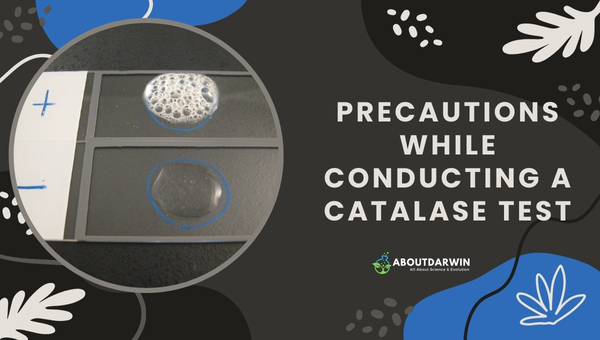Physical Address
304 North Cardinal St.
Dorchester Center, MA 02124
Ever wondered how professionals detect certain diseases or identify distinct types of bacteria? Then, hold onto your curiosity, as this article is the perfect read for you! We will delve into the intriguing science of the Catalase Test, revealing its principles, uses, and how it’s conducted.
Get ready to uncover a procedure that serves an integral part in medical diagnoses and bacterial detection!
The Catalase Test leverages our body’s natural enzyme – catalase. This enzyme plays an imperative role in decomposing harmful substances like hydrogen peroxide into water and oxygen, keeping us healthy.
By examining its presence or absence in human blood samples or bacterial colonies, professionals can diagnose potentially dangerous conditions, such as chronic granulomatous disease, or identify bacteria like Staphylococci. Essentially, this test has a significant impact on both human health and microbial studies.
Contents
The Catalase test is a simple yet insightful procedure that has applications in different fields. It’s not only a crucial diagnostic tool in healthcare, but it’s also used for identifying certain bacteria types.

Let’s delve into understanding its principle, starting with knowing about the role of catalase enzyme and then how this test uses it.
Catalase is essentially an enzyme found in nearly all living organisms that are exposed to oxygen. This includes human cells and several kinds of bacteria. The primary function of this enzyme inside our body can be summed up in two main points:
Thus, catalases play a vital role in protecting cells from oxidative damage, which could otherwise lead to various health conditions, including cancer and premature aging.
Now that we understand what catalases do within organisms let’s see how they are utilized during a Catalase Test.
Indicates the Presence of Catalase Enzyme: Primarily, this test works on identifying if an organism produces and presents catalase enzymes or not.
Reaction With Hydrogen Peroxide: During the testing process, a sample from an organism (human tissue or bacterial colony) is treated with hydrogen peroxide solution.
Observing for Bubble Formation: If catalases are present, they will break down this hydrogen peroxide into water and oxygen, leading to visible bubble formation.
Evaluation Based on Bubble Formation: The occurrence of bubbling or frothing is considered a positive test result, indicating the presence of catalases.
In this manner, the Catalase Test uses the basic biological principle of enzyme action, utilizing catalase’s ability to reduce hydrogen peroxide into harmless water and oxygen. This helps in diagnosing certain medical conditions or the identification of specific types of bacteria.
Also Read: Planning a Perfect Family Reunion: A Comprehensive Guide
Catalase tests are a valuable resource in several branches of science and medicine, providing essential insights into the presence and functionality of catalase enzymes within an organism. Notably, these tests fulfill two significant roles in medical diagnosis and bacterial identification.
The production of catalase enzymes is a natural process within our bodies that allows us to regulate reactive oxygen species such as hydrogen peroxide. These enzymes play an important role in preventing damage to cells due to oxidative stress.
Deficiency or overproduction of catalase can be indicative of some health issues, directly linking it to several disease processes:
By offering quick insights into the enzyme’s presence and activity level, these tests open a window for doctors into potential medical problems that may otherwise fly under the radar.
In microbiology labs across the globe, bacterial colonies pass through application after application on their road to identification; one such stop is often at what’s known as a ‘catalase test.’
This simple yet informative procedure serves as an effective protocol for differentiating between bacteria based on their inherent ability—or lack thereof—to produce catalases:
This distinctive reaction of bacterial species to the catalase test provides a useful aid in classifying, comparing, and identifying different samples in a laboratory setting.
Also Read: Unlock DNA Discoveries: Free DNA Upload Websites Guide
Conducting a catalase test requires meticulous handling and strict adherence to a detailed procedure. Here are the steps involved, from preparation to execution.
Before you can conduct a catalase test, several crucial measures need to be taken:
The actual process of running a catalase test can take different forms, but one common approach is as follows:
Step 1: Take your microscope slide and place a small quantity of the sample being tested on it.
Step 2: Pour or drop some hydrogen peroxide (3%) onto the specimen placed on the slide.
Step 3: Observe for bubble formation; this happens if the bacteria produces a catalase enzyme that breaks down hydrogen peroxide into water and oxygen gas. The presence of oxygen gas leads to bubble formation.
Step 1: Transfer culture from an agar plate or broth media into an empty tube using your inoculating loop.
Step 2: Add about 2-4 ml of hydrogen peroxide(3%) solution into each tube which contains different cultures.
Step 3: Cap tubes gently and gently invert them, making sure not to spill any content cause a large amount could create a violent reaction.
Step 4: Check for bubbles formation in the tube that shows a positive test.
Note: The slide method is typically safer than the tube method as it uses less hydrogen peroxide and provides less chance of explosive reaction. Still, care should be taken during both methods to avoid accidental splash causing harm to mucus and skin, which can be corrosive.
Also Read: Uncover 1890 Census Substitutes for Genealogical Insights
Interpreting results from the catalase test provides insights into whether certain bacteria carry the enzyme catalase. This gives medical practitioners important information about possible infections in the human body and helps guide treatment protocols.
Interpreting the results of a catalase test involves understanding what positive and negative outcomes mean in a practical sense:
Positive Result: A positive result occurs when oxygen gas bubbles are visible after hydrogen peroxide (H2O2) is added to a bacterial sample. This means that the bacterial species present produce the enzyme catalase, which breaks down hydrogen peroxide into water and oxygen.
Example:
Staphylococci, Pseudomonas aeruginosa, and Aspergillus are bacteria that often yield positive results.
Table 1: Example of Positive Result Bacteria
| Bacterial Species | Result |
|---|---|
| Staphylococci | Positive |
| Pseudomonas aeruginosa | Positive |
| Aspergillus | Positive |
Negative Result: A negative result transpires when no sign of bubble production is observed after H2O2 application. It implies that these bacterial species produce little or no catalase enzymes; thus, they cannot decompose hydrogen peroxide.
For example, Streptococcus and Enterococcus sp often yield negative results.
Table 2: Example of Negative Result Bacteria
| Bacterial Species | Result |
|---|---|
| Streptococcus sp. | Negative |
| Enterococcus sp. | Negative |
Multiple factors might affect the precise outcomes during a catalase test. These influencing components can cause irregularities in expected results:
In general, ensuring correct sampling methods and maintaining quality control in test environments are vital for accurate interpretations during catalase tests. It is always important to discuss any unexpected or ambiguous results with a qualified healthcare provider.
Also Read: Unlock DNA Discoveries: Free DNA Upload Websites Guide
Conducting a Catalase test demands the utmost caution and precise adherence to various safety measures.

This ensures you not only get accurate results but also avoid causing unnecessary harm or contamination in the laboratory setting. Below are some crucial aspects to consider:
With respect to safety measures, the following precautions must be strictly upheld when carrying out a catalase test.
Hydrogen peroxide is an oxidizing agent used in this test; it can cause skin burns or eye damage if mishandled.
Adhering strictly to these safety measures helps obtain reliable results while ensuring one’s well-being in the laboratory environment remains unharmed during and after testing.
Therefore, it’s pivotal that such precautions form an integral part of the operational procedures within one’s bio-laboratory setting for any catalase testing being performed there.
Also Read: Understanding Your Brother’s Wife Role: A Comprehensive Guide
The main function of the Catalase enzyme is to break down potentially harmful substances like hydrogen peroxide into harmless elements like water and oxygen.
Yes, a Catalase test can aid in identifying different types of bacteria based on their production levels of catalase, aiding in bacterial classification and diagnosis.
Precautions are important during a Catalase Test to prevent any risk of contamination, ensure accurate results and maintain safety standards while handling biological materials.
Generally, conducting catalasetests does not have known risks; however, too frequent testing without reasonable cause may lead to misinterpretation or unnecessary medical actions. It’s best to take tests as advised by your healthcare provider.
Also Read: Isostatic Rebound: Uncovering Post-glacial Rebound Process
The catalase test is an important tool in medical diagnosis and microbial identification. Understanding the principle behind it, including the role of catalase enzyme and its function, helps appreciate the science behind this widely used method.
Conducting a catalase test requires careful preparation and a step-by-step procedure to ensure accurate results. Also crucial is understanding how to interpret those results, what positive and negative outcomes mean, and what factors might affect these results.
With all tests come precautions – safe handling of bacteria cultures, glassware, and hydrogen peroxide is essential when carrying out a Catalase Test.